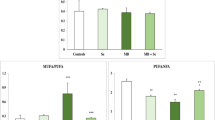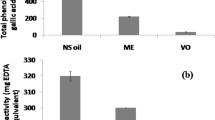Abstract
Purpose
The objective of this study was to evaluate the capacity of modified phenols synthesized from hydroxytyrosol, a natural olive oil phenol, specifically those containing a selenium or sulphur group, to inhibit lipid peroxidation.
Methods
The compounds’ abilities to inhibit lipid peroxidation in liver microsomes obtained from vitamin E-deficient rats were compared to hydroxytyrosol.
Results
All synthetic compounds had a significant higher ability to inhibit lipid peroxidation than hydroxytyrosol. Selenium derivates displayed a higher antioxidant activity than sulphur derivatives. In addition, the antioxidant activity increased with a higher number of heteroatoms in the hydroxytyrosol molecular structure.
Conclusion
The study shows, for the first time, the ability of synthetic compounds, derived from the most active phenol present in olives in free form (hydroxytyrosol), and containing one or two atoms of sulphur or selenium, to inhibit the lipid peroxidation of vitamin E-deficient microsomes. The antioxidant activity of five thioureas, a disulfide, a thiol, three selenoureas, a diselenide, and a selenonium were evaluated and the results showed a higher inhibition of lipid peroxidation than the natural phenol. Selenium and sulphur derivatives of hydroxytyrosol are novel antioxidants with the potential to supplement the lack of vitamin E in the diet as natural alternatives for the prevention of diseases related to oxidative damage.


Similar content being viewed by others
References
Ruiz-Canela M, Estruch R, Corella D, Salas-Salvado J, Martínez-González MA (2014) Association of Mediterranean diet with peripheral artery disease: the PREDIMED randomized trial. J Am Med Assoc 311:415–417
Trichopoulou A, Costacou T, Bamia C, Trichopoulou D (2003) Adherence to a Mediterranean diet and survival in a Greek population. N Engl J Med 348:2599–2608
Buckland G, Travier N, Barricarte A, Ardanaz E, Moreno-Iribas C, Sanchez MJ, Molina-Montes E, Chirlaque MD, Huerta JM, Navarro C, Redondo ML, Amiano P, Dorronsoro M, Larranaga N, Gonzalez CA (2012) Olive oil intake and CHD in the European Prospective Investigation into Cancer and Nutrition Spanish cohort. Br J Nutr 108:2075–2082
Carluccio MA, Siculella L, Ancora MA, Massaro M, Scoditti E, Storelli C, Visioli F, Distante A, De Caterina R (2003) Olive oil and red wine antioxidant polyphenols inhibit endothelial activation: antiatherogenic properties of Mediterranean diet phytochemicals. Arterioscler Thromb Vasc Biol 23:622–629
González-Santiago M, Martín-Bautista E, Carrero JJ, Fonolla J, Baro L, Bartolomé MV, Gil-Loyzaga P, López-Huertas E (2006) One-month administration of hydroxytyrosol, a phenolic anti-oxidant present in olive oil, to hyperlipemic rabbits improves blood lipid profile, antioxidant status and reduces atherosclerosis development. Atherosclerosis 188:35–42
Visioli F, Poli A, Galli C (2002) Anti-oxidant and other biological activities of phenols from olives and olive oil. Med Res Rev 22:65–75
Aruoma OI (1998) Free radicals. Oxidative stress and antioxidants in human health and disease. J Am Oil Chem Soc 75:199–212
Duthie GG, Morrice P (2012) Anti-oxidant capacity of flavonoids in hepatic microsomes is not reflected by anti-oxidant effects in vivo. Oxidative Medicine and Cellular Longevity, ID 165127
Fernández-Bolaños J, Rodríguez G, Gómez E, Guillén R, Jiménez A, Heredia A, Rodríguez R (2004) Total recovery of the waste of two-phase olive oil processing: isolation of added-value compounds. J Agric Food Chem 52:5849–5855
Fernández-Bolaños J, Rodríguez G, Lama-Muñoz A, Sánchez P (2011) Dispositivo y procedimiento para el tratamiento de los subproductos de la obtención del aceite de oliva. International Patent Number PCT/ES2011/070583
Rubio-Senent F, Rodríguez-Gutiérrez G, Lama-Munoz A, Fernández-Bolaños J (2012) New phenolic compounds hydrothermally extracted from the olive oil by-product alperujo and their antioxidative activities. J Agric Food Chem 60:1175–1186
Fernandez-Bolaños J, Rodríguez G, Rodríguez R, Heredia A, Guillén R, Jiménez A (2002) International Patent Number PCT/ESO2/00058
Fernández-Bolaños J, Rodríguez G, Rodríguez R, Heredia A, Guillén R, Jiménez A (2002) Production in large quantities of highly purified hydroxytyrosol from liquid-solid waste of two-phase olive oil processing or “alperujo”. J Agric Food Chem 50:6804–6811
Rubio-Senent F, de Roos B, Duthie G, Fernández-Bolaños J, Rodríguez-Gutiérrez G (2015) Inhibitory and synergistic effects of natural olive phenols on human platelet aggregation and lipid peroxidation of microsomes from vitamin E-deficient rats. Eur J Nutr 54:1287–1295
Franke KW (1934) A new toxicant occurring naturally in certain samples of plant foodstuffs I. Results obtained in preliminary feeding trials. J Nutr 8:597–608
Bhabak KP, Mugesh G (2007) Synthesis, characterization, and antioxidant activity of some ebselen analogues. Chemistry 13:4594–4601
Arner ES, Holmgren A (2000) Physiological functions of thioredoxin and thioredoxin reductase. Eur J Biochem 267:6102–6109
Li F, Wang F, Yu F, Fang Y, Xin Z, Yang F, Xu J, Zhao L, Hu Q (2008) In vitro antioxidant and anticancer activities of ethanolic extract of selenium-enriched green tea. Food Chem 111:165–170
Koketsu M, Ishihara H, Hatsu M (1998) Novel compounds, 1,3-selenazine derivatives, as antibacterial agents against Escherichia coli and Staphylococcus aureus. Res Commun Mol Pathol Pharmacol 101:179–186
Fernández-Bolaños JM, Maya I, López-García MA, Fernández-Bolaños J, Rodríguez-Gutiérrez G, Gómez-Carretero A (2012) National Patent Request Number 2:392–915
Rodríguez-Gutiérrez G, Duthie GG, Wood S, Morrice P, Nicol F, Reid M, Cantlay LL, Kelder T, Horgan GW, Fernández-Bolaños J, de Roos B (2012) Alperujo extract, hydroxytyrosol, and 3,4-dihydroxyphenylglycol are bioavailable and have anti-oxidant properties in vitamin E-deficient rats proteomics and network analysis approach. Mol Nutr Food Res 56:1137–1147
Duthie GG, González BM, Morrice PC, Arthur JR (1991) Inhibitory effects of isomers of tocopherol on lipid-peroxidation of microsomes from vitamin E-deficient rats. Free Radical Res Commun 15:35–40
Burczynski JM, Southard SJ, Hayes JR, Longhurst PA, Colby HD (2001) Changes in mitochondrial and microsomal lipid peroxidation and fatty acid profiles in adrenal glands, testes, and livers from α-tocopherol-deficient rats. Free Radic Biol Med 30:1029–1035
Mitchell JH, Gardner PT, McPhail DB, Morrice PC, Collins AR, Duthie GG (1998) Anti-oxidant efficacy of phytoestrogens in chemical and biological model systems. Arch Biochem Biophys 360:142–148
Acknowledgements
The research of BDR and GD is funded by the Scottish Government’s Rural and Environment Science and Analytical Services (RESAS) division. This research was funded by the Spanish Ministry of Economy and Competitiveness and co-funded by the European Social Fund (ESF) (Project AGL2016-79088R). GRG wishes to thank the “Ramón y Cajal” Program (RYC-2012-10456 contract), co-funded by the ESF.
Author information
Authors and Affiliations
Corresponding author
Ethics declarations
Conflict of interest
Authors declare that they have no conflict of interest.
Rights and permissions
About this article
Cite this article
Rodríguez-Gutiérrez, G., Rubio-Senent, F., Gómez-Carretero, A. et al. Selenium and sulphur derivatives of hydroxytyrosol: inhibition of lipid peroxidation in liver microsomes of vitamin E-deficient rats. Eur J Nutr 58, 1847–1851 (2019). https://doi.org/10.1007/s00394-018-1733-y
Received:
Accepted:
Published:
Issue Date:
DOI: https://doi.org/10.1007/s00394-018-1733-y




